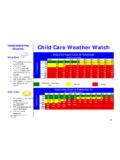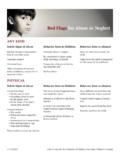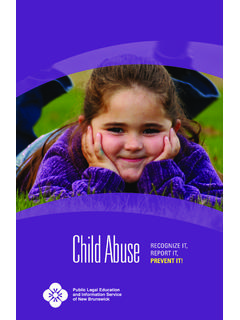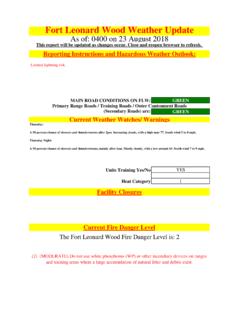Transcription of Airborne Allergens--Something in the Air Cover illustration
1 Airborne Allergens something IN THE AIR DEPARTMENT OF HEALTH AND HUMAN SERVICES National Institutes of Health National Institute of Allergy and Infectious Diseases Airborne Allergens something IN THE AIR DEPARTMENT OF HEALTH AND HUMAN SERVICES National Institutes of Health National Institute of Allergy and Infectious Diseases NIH Publication No. 03-7045 April 2003 Contents 1 Introduction 4 Symptoms 6 Pollen Allergy 10 Mold Allergy 14 Dust Mite Allergy 16 Animal Allergy 17 Chemical Sensitivity 18 Diagnosis 20 Prevention 25 Treatment 28 Allergy Research 32 Glossary 34 More Information Introduction Sneezing is not always the symptom of a cold.
2 Sometimes, it is an allergic reaction to something in the air. Health experts estimate that 35 million Americans suffer from upper respiratory tract symptoms that are allergic reactions to Airborne allergens. Pollen allergy, commonly called hay fever, is one of the most common chronic diseases in the United States. Worldwide, Airborne allergens cause the most problems for people with allergies. The respiratory symptoms of asthma, which affect approximately 11 million Americans, are often provoked by Airborne allergens. Overall, allergic diseases are among the major causes of illness and disability in the United States, affecting as many as 40 to 50 million Americans.
3 The National Institute of Allergy and Infectious Diseases (NIAID) of the National Institutes of Health (an agency of the Department of Health and Human Services) supports and conducts research on allergic diseases. The goals of this research are to provide a better understanding of the causes of allergy, to improve methods for diagnosing and treating allergic reactions, and eventually to prevent allergies. This booklet summarizes what health experts know about the causes and symptoms of allergic reactions to Airborne allergens, how health care providers diagnose and treat these reactions, and what medical researchers are doing to help people who suffer from these allergies.
4 Note: Words in bold are defined in the glossary at the end of this booklet. 1 What is an allergy? An allergy is a specific reaction of the body s immune system to a normally harmless substance, one that does not bother most people. People who have allergies often are sensitive to more than one substance. Types of allergens that cause allergic reactions include Pollens House dust mites Mold spores Food Latex rubber Insect venom Medicines Why are some people allergic? Scientists think that some people inherit a tendency to be allergic from one or both parents. This means they are more likely to have allergies.
5 They probably, however, do not inherit a tendency to be allergic to any specific allergen . Children are more likely to develop allergies if one or both parents have allergies. In addition, exposure to allergens at times when the body s defenses are lowered or weakened, such as after a viral infection or during pregnancy, seems to contribute to developing allergies. 2 What is an allergic reaction? Normally, the immune system functions as the body s defense against invading germs such as bacteria and viruses. In most allergic reactions, however, the immune system is responding to a false alarm.
6 When an allergic person first comes into contact with an allergen , the immune system treats the allergen as an invader and gets ready to attack. The immune system does this by generating large amounts of a type of antibody called immunoglobulin E, or IgE. Each IgE antibody is specific for one particular substance. In the case of pollen allergy, each antibody is specific for one type of pollen. For example, the immune system may produce one type of antibody to react against oak pollen and another against ragweed pollen. The IgE molecules are special because IgE is the only type of antibody that attaches tightly to the body s mast cells, which are tissue cells, and to basophils, which are blood cells.
7 When the allergen next encounters its specific IgE, it attaches to the antibody like a key fitting into a lock. This action signals the cell to which the IgE is attached to release (and, in some cases, to produce) powerful chemicals like histamine, which cause inflammation. These chemicals act on tissues in various parts of the body, such as the respiratory system, and cause the symptoms of allergy. 3 Symptoms The signs and symptoms of Airborne allergies are familiar to many. Sneezing, often with a runny or clogged nose Coughing and postnasal drip Itching eyes, nose, and throat Watering eyes Conjunctivitis Allergic shiners (dark circles under the eyes caused by increased blood flow near the sinuses) Allergic salute (in a child, persistent upward rubbing of the nose that causes a crease mark on the nose) In people who are not allergic, the mucus in the nasal passages simply moves foreign particles to the throat, where they are swallowed or coughed out.
8 But some thing different happens in a person who is sensitive to Airborne allergens. In sensitive people, as soon as the allergen lands on the lining inside the nose, a chain reaction occurs that leads the mast cells in these tissues to release histamine and other chemicals. The powerful chemicals contract certain cells that line some small blood vessels in the nose. This allows fluids to escape, which causes the nasal passages to swell resulting in nasal congestion. Histamine also can cause sneezing, itching, irritation, and excess mucus production, which can result in allergic rhinitis.
9 4 Other chemicals released by mast cells, including cytokines and leukotrienes, also contribute to allergic symptoms. Some people with allergy develop asthma, which can be a very serious condition. The symptoms of asthma include Coughing Wheezing Shortness of breath The shortness of breath is due to a narrowing of the airways in the lungs and to excess mucus production and inflammation. Asthma can be disabling and sometimes fatal. If wheezing and shortness of breath accompany allergy symptoms, it is a signal that the airways also have become involved. Is it an allergy or a cold?
10 There is no good way to tell the difference between allergy symptoms of runny nose, coughing, and sneezing and cold symptoms. Allergy symptoms, however, may last longer than cold symptoms. Anyone who has any respiratory illness that lasts longer than a week or two should consult a health care provider. 5 Pollen Allergy Each spring, summer, and fall, tiny pollen grains are released from trees, weeds, and grasses. These grains hitch rides on currents of air. Although the mission of pollen is to fertilize parts of other plants, many never reach their targets. Instead, pollen enters human noses and throats, triggering a type of seasonal allergic rhinitis called pollen allergy.






